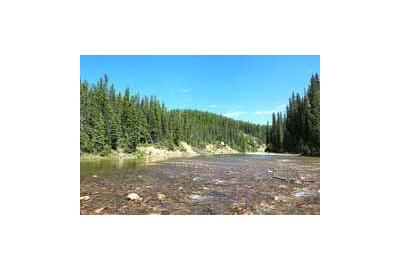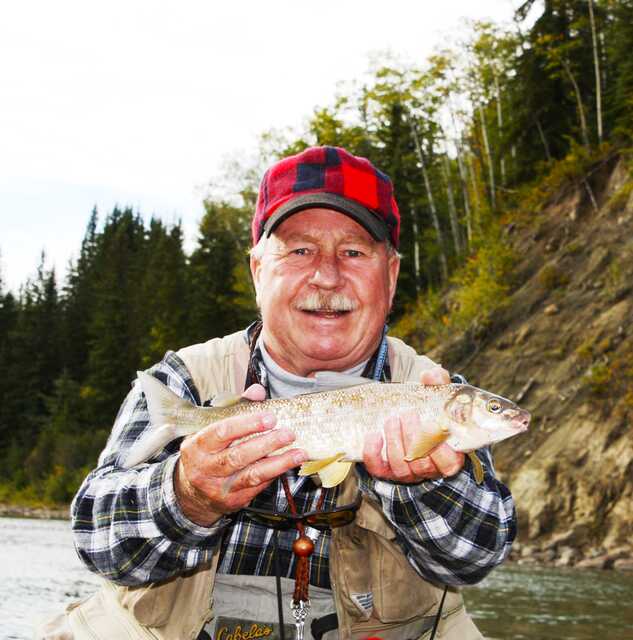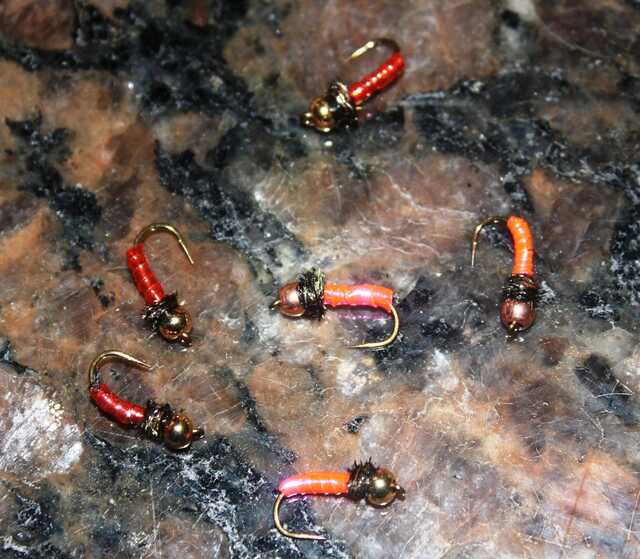When it comes to handing out the angling hardware hereabouts, it’s not a very crowded podium.
Cold-water trout, and rainbows in particular, perennially share the laurel wreath with their warmer-water cousins the walleye.
All other species, worthy as they may be, come in well up the track when Alberta anglers are polled for their preferences.
Everyone, of course, is entitled to their opinion. It’s our democratic right as anglers to disagree.
But one fish species that could use a little love is the humble mountain whitefish – a prolific bug-eater that inhabits rivers up and down the Eastern Slopes and out onto the flat land beyond.
But then again in the spirit of full disclosure, I must admit I’m prejudiced.
I cut my 12-year angling molars on Alberta historic Coal Branch where the mighty McLeod – a prolific whitefish river - was a short bike ride from my home. (And a longer trip back because we had a steep push up the river hill.)
While a quirky Athabascan rainbow trout creek was only a few metres out the back door.
But it was the rockies that all the boys keyed on. Same with their coal miner dads who filled their wicker creels with them, especially during the late summer runs.
Back in those days you ate what you caught or what was the point. And bag limits were generous.
Sadly that was then this is now.
And the entire Front Range is for practical purposes a catch-and-release fishery. Like famous American fly-fishing author and pioneer Lee Wulff said, “a trout is too valuable to be caught only once.”
Except with mountain whitefish, if you want to fry one or two, a restricted harvest on many drainages still exists.
Unlike south of the Medicine Line where a disturbing practice known as the “Montana handshake”, wreaked havoc on mountain whitefish populations.
Where anglers released unwanted whitefish with a lethal squeeze under the misguided belief that they were giving favoured trout populations a boost by eliminating their habitat competitors.
Outdoors men and women began the conservation movement and have always promoted ethical and sustainable fish and wildlife management.
Not only is the “handshake” gross and reprehensible, it’s also illegal and could earn practitioners a stiff fine and loss of angling privileges and tackle. So don’t even think about it.
While rocky angling is similar to moving-water trout fishing there are significant differences. Maybe not night and day, but clearly dawn and dusk.
Rockies may not be the prettiest fish that swims in our mountain rivers. But with trout populations dwindling for a number of reasons while angling pressure increases, the White Knights of the Alberta Rockies can turn a frustrating fishing trip into a Rocky Mountain high. Even though they are actually burnished gold in colour.
Here are a few pertinent tips to make it happen.
Rocky Country
As mentioned above, mountain whitefish and our trout species – both native and introduced – mostly share our Eastern Slopes rivers.
But not necessarily the same water. Rockies are happier at home in the hard flowing freestones whose rock-strewn riffles are sculpted by spring runoffs and summer floods.
Which pretty well describes every river from south of Grande Prairie to the border.
Mountain whitefish inhabit parts of the rivers where trout don’t go. Streamy water of four to six feet deep. If there is a current interface, usually defined by a “seam”, so much the better.
Pool heads and tail-outs are also prime whitefish water as are runs broken up by boulders providing the fish a break from the heavy current.
Rockies are denizens of the bigger water like the Crowsnest, Bow, Red Deer and the above-mentioned McLeod and are rarely found in the feeder streams and meadow creeks where trout and grayling are the primary species.
Mountain Whitefish Tactics
One memorable afternoon on the upper McLeod, when golden stonefly nymphal shucks were plastered on the stream-side rocks, I had a cosmic few hours dry-fly fishing for rockies with a Yellow Stimulator.
Clearly that was the exception, not the rule.
Most successful mountain whitefish angling occurs with the lure down on the rocks.
The traditional technique of my youth was to bait a pair of classic wet flies on short nylon “snells” with a maggot or two.
Then swing the rig down and around through the whitefish holding water with enough split-shot pinched onto the leader to get the flies ticking on the bottom.
The rod was a “telescopic” fly rod and a level wind reel which you would be hard-pressed to find in tackle stores these days.
A standard spincaster rod and reel can be substituted and a fly rod with a sinking or sink-tip line can he an effective fish-getter when swung through the riffles in classic wet-fly style.
But the set-up that I prefer more times than not is a pair of nymphs (where legal) under a strike indicator with a 5-weight 8-foot fly rod. Although a spin-caster will work too.
Cast to the head of the pool then allow the indicator to work down the water. Whenever it bobbles, hesitates or disappears lift the rod and set the hook.
Sadly don’t expect every whitefish caught to come to the net. Rockies have an little, turned-down mouth and are hard to hook – even harder to hold – and should be played gently to prevent the fly from coming loose.
Also, smaller hook sizes down to 16 or 18 will increase the hook-up rate exponentially.
Anglers should also make themselves familiar with the specific regulations for any watershed before heading west on a mountain whitefish expedition – especially if you’re planning on a harvest.
The regs can wary significantly from river to river and anglers are faced with a different set of rules when it comes to the National Parks where excellent rocky angling also occurs.


When to Fish
A standard spincaster rod and reel can be substituted and a fly rod with a sinking or sink-tip line can he an effective fish-getter when swung through the riffles in classic wet-fly style.
But the set-up that I prefer more times than not is a pair of nymphs (where legal) under a strike indicator with a 5-weight 8-foot fly rod. Although a spin-caster will work too.
Cast to the head of the pool then allow the indicator to work down the water. Whenever it bobbles, hesitates or disappears lift the rod and set the hook.
Sadly don’t expect every whitefish caught to come to the net. Rockies have an little, turned-down mouth and are hard to hook – even harder to hold – and should be played gently to prevent the fly from coming loose.
Also, smaller hook sizes down to 16 or 18 will increase the hook-up rate exponentially.
Anglers should also make themselves familiar with the specific regulations for any watershed before heading west on a mountain whitefish expedition – especially if you’re planning on a harvest.
The regs can wary significantly from river to river and anglers are faced with a different set of rules when it comes to the National Parks where excellent rocky angling also occurs.
This provides a bonus fishery to rivers – whether through the intervention of man like hydro dams or milder climate conditions from warm winter chinook winds – that are relatively free of ice to allow angling when other fisheries are locked tight with ice.
But again, check the regs because many rivers have winter closures.
Tackle and Gear
A standard trout flyrod loaded with a floating line is my go-to whitefish set-up.
Rockies are largely sub-surface feeders so anglers shouldn’t head out without a good selection of nymphs like Pheasant Tails, Princes, and Gold-ribbed Hare’s Ears.
Either with beadheads or built-in weight to get the flies down to the strike zone quickly and extend the drift longer.
The Hare’s Ear (or Hare’s Lug as it was called back then) is just effective today as it was when it was first chronicled nearly 200 years ago. Rockies absolutely love it.
Another highly effective mountain whitefish fly is the Laser Wrap in variations of pink or orange transparent plastic film wrapped over silver tinsel with a brass beadhead and a few turns of peacock herl behind it.
What whitefish food source it imitates is anyone’s guess.
But not unlike the similar Mountain Midge made popular on the Crowsnest River the Laser Wrap is a superior winter angling fly.


These flies can either be dead-drifted under an indicator or swung across the current wet-fly style.
Also, don’t overlook the classic wet fly patterns, many brought over from Britain and Scotland.
Flies like the March Brown, Lead-winged Coachman, Blue Dun, Royal Coachman, Dark Montreal, Grizzly King and that beautiful array of flies known as Soft Hackles.
But the secret to success is to get the get them down to the gravel.
If you’re not feeling then ticking occasionally on the rocks, you’re not deep enough. Add a little more split shot or set your indicator deeper.
Will a mountain whitefish tail-walk across the pool like an amped-up rainbow or lead you on a merry chase like a cunning brown trout.
Sadly no.
But they are fine fighters in their own right. Especially when they get up into the 16-inch plus range during the fall spawning runs.
And in true White Knight-style, they can ride to the rescue of a struggling fishing trip to the mountains.
Now if they would only get a little more love








